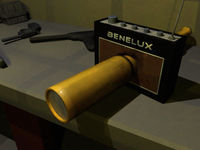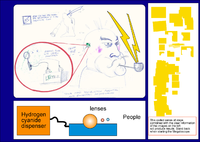User:Multiliteralist/megaloscope2
The Megaloscope is a scientific instrument capable of observing an object clearly, totally regardless of distance. It works equally well as a periscope, a retroscope, a stetoscope and a laser-hydraulic zap cannon. The inventor of Megaloscope, Professor Emeritus Doff, tries to deny this last allegation, but the scientific community is certain he is lying. They will change their minds if they know what's good for them.
“I can take the picture of this flea here and blow it up to GIGANTIC proportions. We can make an advertisement on a skyscraper wall out of an atom. We can see farther than the Moon and even further than that. Then I will blow you all to, er, a better place.”
– Emeritus Doff, the inventor of the Megaloscope
A short history of the deadly magnifying glass and its offspring[edit | edit source]
The historical backround here is provided only to highlight the absolute superiority of the Megaloscope. All previous inventions deserve their places in history only as predecessors.
- 1248: a simple magnifying glass gets invented somewhere in the suburbs of Milan. The principle of the glass has been lost, but archaeologists agree with historians it was closely connected to light changing directions when it hit the instrument, and to some deadly poison. Disgreement has been voiced over this one, and nobody is really convinced the invention was in any way groundbreaking. The name of the inventor is not known.
- 1249: an almost similar invention sees the light of the day. The famous Titus Maximus of Napoli connects two pieces of blue glass to a simple steam kettle with the intestine of a sheep and succeeds in diffusing light and hurting his finger. He sees nothing through his invention, nor can he kill anyone with it, and dies a broken man a few years later.
- 1250: Leopold the Mean, Emperor of the Unholy Roman Empire, decrees the scientists of his court will have to come up with a workable principle for a magnifying glass that shoots arrows - or lose their heads. The scientists make several attempts but to no avail. The rest of the scientists democratically blame the failure on Claudius the Greek, whom they all hate. Claudius loses his head for all of them.
- 1251: there is a growing need in Bretagne for "a glass that makes everything so that it is big, and kills the enemies", as per the diaries of several traveling monks (Albertus the Franciscan to name one). Nobody is interested in starting a project to produce such a glass.
- 1651: Galileo Galilei the Gaul invents the first working retroscope and studies the heavens with it, simultaneously blowing the immediate neighbourhood up with the strengthened gunpowder he uses in the instrument. He gets banned by the Catholic Church for being the Antichrist, and flees the continent.
- 1700-1850: several nameless scientists succeed in improving the mass destruction side of the retroscope, thereby obliterating themselves (and their immediate surroundings) almost to a man. The magnifying power of the 'scope gets less attention during the period - but allegedly the Moon was clearly visible through most of the improved versions. Of these scientists, only one is worth mentioning:
- 1838: Ruckhard Watt, the son of the famous Diane Watt, boosts the retroscope with his own invention, lectric. He leads lectric to the 'scope at precise intervals and produces some moving pictures of magnified stars on a blank wall. Anyone to even glimpse at the pictures is seized by a severe headache and spasms, and dies in minutes. The scientific community criticizes the invention heavily, claiming it is wrong to kill people in such a harmful way. Watt himself is disappointed with the inefficiency of the instrument, and has a look at the pictures to see if anything could be done to remedy the problem.
- 1902: Bertha Franklin takes the first tentative steps towards producing a really efficient lectric retroscope. She is the first one to use hydrogen cyanide as the effective agent. She dies during the first experiments.
- 1952: Thomas Alvar Edition, the uncle of Emeritus Doff, finds Franklin's papers. After studying them for some weeks, he builds a radiotelescope - which in his opinion is a worthless invention by itself - and connects it with a bandsaw to get rid of his critics. He doesn't succeed in hurling the produced energy far enough, the magnifying power of the telescope being only 200000:1. He quits tampering with the invention after some test runs and concentrates on more traditional methods of disposing of his enemies.
The life of Emeritus Doff in a nutshell[edit | edit source]
- 1958: Emeritus Doff is born the son of a wealthy, nameless merchant of illegal substances somewhere in the USA. His parents live on the road, mostly in hiding. Doff's childhood is far from being miserable - there is always something exciting happening: shootouts, standoffs, blow-overs.
- 1965: at the age of seven, after a barroom brawl where his father is severely wounded, Doff develops a healthy interest in pieces of glass that magnify things and are capable of killing people.
- 1970: at the age of 12 Doff goes to school voluntarily after finding out the schools used miniscopes. He wants to see if they are good murder weapons. He gets expelled after bleeding a schoolmate almost to death with a rusty miniscope.
- 1972: Doff's parents die in a shootout with some criminals. Doff hitch-hikes to Caliphornia to work in his uncle's workshop. His uncle, Thomas Alvar Edition, is first sceptical about the boy's talents - but once Doff terminates a hamster by blasting it with a pair of spectacles, Edition decides to adopt him.
- 1974: Emeritus Doff happens to see the radiotelescope in Thomas Alvar Edition's workshop. He doesn't understand the working principle of the device, but the murderous look of it leaves a lasting impression on his mind. He decides to imitate the general idea.
- 1978: after numerous false starts, Doff produces the Anyscope. It radiates harmful white light while magnifying 17 million times. There are problems, though: the light radiates in all directions at once. Doff understands its usefulness as a last-resort observational weapon, but decides to aim a little higher. The Anyscope is dismantled.
- 1989: Emerits Doff hits the jackpot: he succeeds at observing the rings of Saturn with his first actual Megaloscope, simultaneously obliterating a small village in the Andes.
- 2002: Doff enters negotiations with HUMP about using the Megaloscope to spy the Interwebs users, killing them if they do something wrong (as defined by HUMP). The negotiations are cut short when HUMP representatives find out Doff is on the Inter-Intel wanted list for the Andes mass murder.
- 2007: The Inter-Intel is baffled: Doff's hiding place cannot be found. It is rumoured he has dismantled himself along with the Megalovault (mentioned in a letter to his colleagues in Paris), only to be put back together in the near future.
The theory and practice of megaloscopy[edit | edit source]
Mathematical proof[edit | edit source]
In the words of Emeritus Doff:
- "The exact mathematical formula for the path of rays passing through the lenses of the Megaloscope is all too complicated for the layman to understand, not to mention the average scientist. Only someone like me, whose brain has been enlargenified by the Megaloscope, can be brilliant enough to see the light. I don't need to prove anything, do you understand? When I'm ready so strike... the match of science, I mean... you will all understand the power of my brain. MY BRAIN."
Working principles[edit | edit source]
According to Doff, it is possible to take almost any object, coat it with quick-acting poison, and use it as a murder weapon. Even the most adamant sceptics agree this certainly rings true. What most cannot understand, though, is that Doff is capable of amplifying the effect of the poison by rays of light and lectric. There is no point of explaining this any further. If you cannot understand the principles by now, no explanation will suffice. You will se how it works when we are ready.



